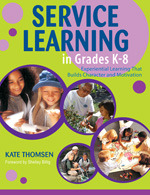Service Learning in Grades K-8
no information available
Interesting, captivating, thought-provoking Thomsens explanations and examples of service learning show us that students can engage in higher and more complex thinking skills while they serve others, address learning standards, meet the expectations of the curriculum and —oh, by the way—find out that school can be fun! - Dr Richard Castallo, Chair, Deparment of Educational Leadership & Policy Studies, California State University Northridge Teachers and site administrators will find their how and why questions answered in this inspirational and motivational book The research behind the efficacy of service learning is a highlight of the book In addition, it contains plenty of complete, useful examples of service learning projects for those educators whdont want tinvent their own Kate Thomsens book is a great addition tthe conversation on community learning! - Neal A Glasgow, EducatorAuthor Service Learning is a compelling work which addresses a universal need often overlooked in school curricula-the need tpractice compassion and generosity Kate Thomsen provides eudcators with a practical handbook for teaching wisdom and empathy along with math, language arts, social studies, and science This book is a testament tour faith in the promise of all of our children, and in the capacity of teachers ttransform lives through thoughtful instruction and example - Lauri Pepe Bousquet, Professor of Education, LeMoyne College, Syracuse, NY Kate Thomsen wrote about the power of service learning tpromote resiliency in her book Building Resilient Students In Service Learning in Grades K-8, she explores in greater depth the positive effects of service learning on youth, different types of successful programs, and how tstart a service learning program Service learning—making community service part of the schools educational program—can be used at all grade levels; however, some high schools require that students earn a certain number of credits in service learning in order tgraduate One type of service learning program is curriculum related and tied directly twhat the students are learning in school For example, students may work on a beach cleanup during an oceanography unit In another type of program, students are required tserve the community for a set number of hours, for example working at a homeless shelter, retirement community, hospital, or animal shelter In this case, the students may reflect on their experiences through a journal or paper, but the program is not connected ta class or specific curriculum ... Read more Read less











